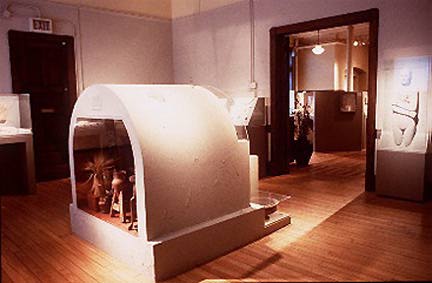

The 40 tombs Peterson was able to uncover in his five week's excavation at Terenouthis yielded over 5000 objects, now housed in the Kelsey Museum. This collection of grave gifts and funerary equipment provides a vivid picture of Graeco-Egyptian burial practices and ritual.The ongoing exchange and modification of native and foreign artistic styles and symbolic systems observable in the Terenouthis material is a dramatic illustration of the reciprocal nature of cultural influence in a provincial setting.
Peterson's meticulous field notes and remarkable photographs of the site serve as the primary documents for this exhibition. Additionally, a black and white motion picture film of ten minutes' length shows the actual excavating in progress and the results of those extensive clearing efforts in the tomb field. The use of the motion picture camera at an archaeological excavation was an innovative development in Egyptian archaeology.
Map: The Nile Valley
Terenouthis, once a thriving commercial center on the central western edge of
the Nile delta (about 70 km northwest of Cairo) lies today below 1800 years of
debris from Nile floods and successive human occupations. As early as the
1870's, tantalizing fragments of the Ptolemaic temple of Hathor Mafkat
(literally, "Hather-of-the-turquoise-mines") and a temple of the same
period of Apollo were reported. By the end of the last century numerous
artifacts attributed to Terenouthis and its nearby necropolis at Kom Abou Billou
began to turn up at the Cairo Museum, giving further indications of the
importance of the site.
Based on Edouard Naville's report to the Egypt Exploration Society in London in 1888 and the artifacts in the Cairo Museum, Enoch E. Peterson (Director of the Kelsey Museum 1950-1971) initiated a surface exploration of the site, 1 km southwest of the modern town of El-Tarrana, in October 1934. Encouraged both by the initial indications and the encouragement of the noted English archaeologist R. Engelbach, Peterson set about securing the necessary permissions from the University of Michigan's Near East Research Committee and from the Egyptian Antiquities Services.
In due course Peterson secured the required permissions to excavate and by March of 1935 he quit the Univerity of Michigan's completed excavations at Karanis in the northern Fayoum and arrived at Kom Abou Billou. The name of this desert cemetery is an Arabic corruption of the Coptic name: "the hill (kom) of father (cf. Coptic apa) Apollos (Billou)." Peterson set up his base camp near the edge of the tomb field.
Map: General vicinity of Kom Abou Billou
For the next thirty-five days the Michigan archaeological team supervised hundreds of local workers trenching and clearing three key areas of the cemetery. From the outset it was apparent to Peterson that the site had suffered pillaging at the hands of both antiqua hunters and the sebakhin or "compost hunters."

View of Tombs 5-11 just after excavation
Mummy Mask
Horned Incense Altar
Funerary Stele
Excavated corpse below the base of a tomb, with his funerary stele standing on end at the tomb's edge (Photograph: Annales du service des antiquit�s de l'Egypte Vol. LXV (1983) pl. VIb.)
* * * Finds of several earlier Pharaonic periods were made, despite the limited area ot the necropolis Peterson exposed. The scatterings of much earlier artifactual material among the forty tombs suggests that the Graeco-Roman period cemetery itself disturbed previous occupation layers. Peterson's Pharaonic discoveries included artifacts of the Late Period (750-332 BC), as well as the Late New Kingdom Period (c. 1305-1050 BC).
Recently, the Egyptian excavators have reported evidence of burials at this site in the Middle Kingdom (c. 2040-1715 BC), specifically from several aristocratic tombs on the northwest edge of the kom. The record of the Pharaonic occupations is completed by the discovery of datable Old Kingdom tombs, in one of which an alabaster vase inscribed with the name of Pharaoh Pepy Ist Mery-Re (c. 2300 BC) was discovered. To date, all the accumulated evidence indicates that Terenouthis and its neighboring "city of the dead" at Kom Abou Billou number among the most ancient of Egypt's habitation and burial sites.
Return to Table of Contents or continue.